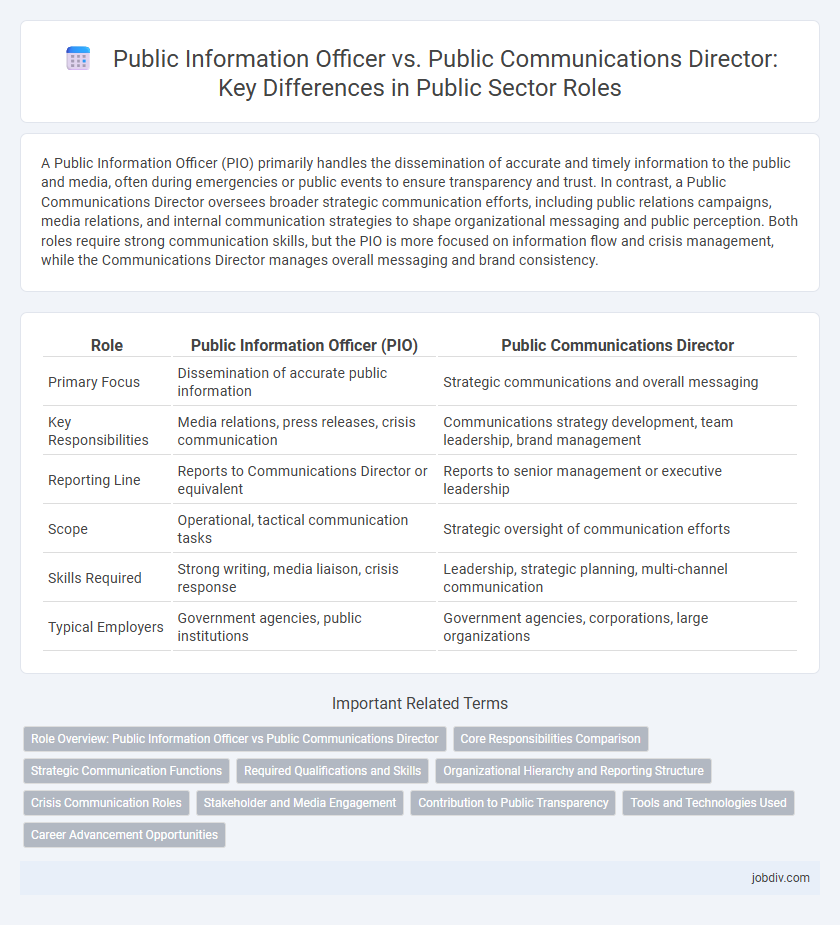A Public Information Officer (PIO) primarily handles the dissemination of accurate and timely information to the public and media, often during emergencies or public events to ensure transparency and trust. In contrast, a Public Communications Director oversees broader strategic communication efforts, including public relations campaigns, media relations, and internal communication strategies to shape organizational messaging and public perception. Both roles require strong communication skills, but the PIO is more focused on information flow and crisis management, while the Communications Director manages overall messaging and brand consistency.
Table of Comparison
| Role | Public Information Officer (PIO) | Public Communications Director |
|---|---|---|
| Primary Focus | Dissemination of accurate public information | Strategic communications and overall messaging |
| Key Responsibilities | Media relations, press releases, crisis communication | Communications strategy development, team leadership, brand management |
| Reporting Line | Reports to Communications Director or equivalent | Reports to senior management or executive leadership |
| Scope | Operational, tactical communication tasks | Strategic oversight of communication efforts |
| Skills Required | Strong writing, media liaison, crisis response | Leadership, strategic planning, multi-channel communication |
| Typical Employers | Government agencies, public institutions | Government agencies, corporations, large organizations |
Role Overview: Public Information Officer vs Public Communications Director
A Public Information Officer (PIO) primarily manages the dissemination of timely and accurate information to the public and media during emergencies or routine operations, ensuring transparency and trust. In contrast, a Public Communications Director oversees the broader strategic communication plan, shaping public perception through marketing, branding, and media relations across multiple channels. The PIO role is often reactive and focused on crisis communication, while the Communications Director role is proactive, driving long-term engagement and organizational messaging initiatives.
Core Responsibilities Comparison
Public Information Officers primarily manage the dissemination of timely, accurate information to the public and media, ensuring transparency during emergencies and routine communications. Public Communications Directors oversee strategic communication planning, brand messaging, and the coordination of various communication channels to align with organizational goals. The core responsibilities of a Public Information Officer center on information flow and crisis management, whereas a Public Communications Director focuses on broader communication strategies and stakeholder engagement.
Strategic Communication Functions
A Public Information Officer (PIO) primarily manages the dissemination of accurate and timely information to the public and media during emergencies or routine operations, ensuring transparency and clarity. A Public Communications Director oversees broader strategic communication functions, including developing comprehensive communication plans, managing public relations, and aligning messaging with organizational goals to enhance reputation and stakeholder engagement. Both roles require expertise in media relations, crisis communication, and message development, but the Communications Director typically operates at a higher strategic level with greater oversight and planning responsibilities.
Required Qualifications and Skills
A Public Information Officer typically requires strong skills in media relations, crisis communication, and information dissemination, with qualifications often including a degree in communications, journalism, or public relations. A Public Communications Director demands advanced strategic communication abilities, leadership experience, and expertise in managing communication teams, frequently supported by extensive background in public affairs or corporate communications. Both roles benefit from excellent writing, interpersonal skills, and proficiency with digital communication platforms to effectively engage diverse public audiences.
Organizational Hierarchy and Reporting Structure
A Public Information Officer (PIO) typically operates within government agencies or public institutions, reporting directly to department heads or senior officials responsible for public affairs. The Public Communications Director holds a higher-level position, overseeing a broader communications strategy and managing multiple public information officers and communication teams across departments. Organizational hierarchy places the Communications Director above the PIO, with the Director responsible for strategic planning, stakeholder engagement, and overall messaging coherence.
Crisis Communication Roles
Public Information Officers (PIOs) specialize in disseminating accurate and timely information to the public during emergencies, ensuring transparency and managing the flow of critical updates. Public Communications Directors oversee broader communication strategies, including crisis communication plans, media relations, and coordination among multiple departments to maintain consistent messaging. In crisis situations, PIOs act as frontline spokespersons, while Public Communications Directors provide strategic oversight and resource allocation to support effective communication responses.
Stakeholder and Media Engagement
Public Information Officers (PIOs) specialize in managing media relations and disseminating timely, accurate information to the public during emergencies or routine updates, ensuring transparency and trust. Public Communications Directors oversee broader communication strategies, coordinating stakeholder engagement across multiple platforms, including media, community groups, and internal teams. Both roles require strong media engagement skills, but PIOs focus on tactical information release while Communications Directors emphasize strategic stakeholder relationship management.
Contribution to Public Transparency
A Public Information Officer (PIO) directly facilitates public transparency by disseminating timely, accurate information and responding to media inquiries to ensure accountability. The Public Communications Director shapes overall messaging strategies, integrating transparency goals into broader communication plans to maintain public trust. Both roles collaboratively enhance transparency, with the PIO handling operational information flow and the Communications Director overseeing strategic communication frameworks.
Tools and Technologies Used
Public Information Officers (PIOs) primarily utilize media monitoring software, press release distribution platforms, and social media management tools to manage information flow and public inquiries effectively. Public Communications Directors leverage advanced analytics software, content management systems, and integrated marketing communication technologies to develop strategic communication campaigns and monitor audience engagement. Both roles benefit from collaboration platforms and real-time communication tools to ensure consistent messaging and rapid response in public relations.
Career Advancement Opportunities
Public Information Officers primarily manage government or organizational information dissemination, making them essential for building foundational communication skills and expertise in media relations. Public Communications Directors oversee broader strategic communication initiatives, offering greater leadership responsibilities and opportunities to influence organizational policy and public perception. Career advancement from Public Information Officer to Public Communications Director typically involves developing advanced strategic planning abilities, project management skills, and a proven track record of successful communication campaigns.
Public Information Officer vs Public Communications Director Infographic

 jobdiv.com
jobdiv.com